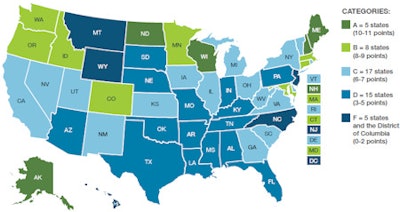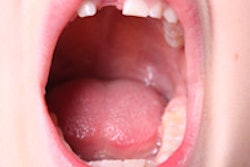
A new report released today by the Pew Center on the States found that 40% of all U.S. states earned either a D or F grade when it comes to providing children with dental sealants, missing a key opportunity to help prevent caries and reduce Medicaid and other health-related costs.
The Pew Children's Dental Campaign released reports in both 2010 and 2011 grading all 50 states and the District of Columbia on children's dental health. Those reports evaluated eight policies covering dental prevention, financing, and workforce issues. This year, Pew chose to focus on sealants.
Research has shown that providing sealants through school-based programs is a cost-effective way to reach low-income children, who are at greater risk of decay, Pew noted in a press release. Although it has been 45 years since the first research paper reported the successful use of sealants, states have been slow to use this prevention strategy. The most recent national survey (2009-2010) revealed that only half of teens ages 13 to 15 had received sealants on a permanent tooth.
This latest report from Pew, "Falling Short: Most States Lag on Dental Sealants," grades all 50 states and the District of Columbia on their efforts to prevent decay by improving access to sealants for low-income children. The data came from surveys of both state dental directors and state dental boards, as well as from the National Oral Health Surveillance System (NOHSS), a database that enables policymakers to identify trends and assess progress.
States were given points for each benchmark, and grades (A-F) were based on the sum of points earned for four benchmarks:
- Having sealant programs in high-need schools -- those with a significant proportion of children whose family income levels increase their risk of decay
- Allowing hygienists to place sealants in school-based programs without requiring a dentist's exam
- Collecting data regularly about the dental health of schoolchildren and submitting it to a national database managed by the Centers for Disease Control and Prevention and the Association of State and Territorial Dental Directors
- Meeting a national objective on sealants set by the federal government's Healthy People 2010 goals.
Here are some of the report's key findings:
Roughly two-thirds of all states do not have sealant programs in a majority of high-need schools. Five states have no programs in these schools.
Nineteen states and the District of Columbia still have a regulation that requires a dentist to examine a child before a hygienist can place a sealant, making sealant programs less cost-effective and ignoring the evidence showing this prerequisite is unnecessary.
Forty states and the District of Columbia could not confirm that they had reached at least 50% of their children with sealants -- the minimum threshold established by Health People 2010.
Nineteen states and the District of Columbia did not submit data from within the past five years on school-age children to the National Oral Health Surveillance System.
Only five states earned an A, and just two of these states (Maine and New Hampshire) received the maximum points possible.
Overall state grades |
| Source: Pew Center on the States, 2012. |
"School-based sealant programs remain an underutilized preventive strategy, despite their proven benefits," the report noted. "While some states have improved their sealant policies since 2010, most are not doing enough to use this cost-effective prevention tool."
Although the eight states that received a B are performing relatively well, half of them did not have sealant programs in a majority of their high-need schools. Meanwhile, 17 states earned C grades, and another 15 received D's, making this grade the largest cluster. Hawaii, New Jersey, Montana, North Carolina, Wyoming, and the District of Columbia all earned F's, meaning they are lagging far behind in prevention efforts.
"States that take dental prevention seriously are making a good faith effort to get sealants to more low-income children," said Shelly Gehshan, director of the Pew Children's Dental Campaign. "When states don't do enough, they -- and low-income children -- pay a higher price both in dollars and decay."
The report also found that between 2010 and 2020, annual Medicaid spending for dental care is expected to climb from $8 billion to more than $21 billion, with children accounting for roughly one-third of the program's total spending on dental services. In 2009, U.S. children made more than 49,000 visits to hospital emergency rooms for preventable dental problems. In South Carolina, for example, nearly 3 out of 4 dental emergency room trips in 2009 were made by Medicaid recipients or the uninsured, meaning taxpayers or other hospital consumers assumed a significant portion of these costs.
"Children's health isn't the only thing that suffers when states don't invest in sealant programs," Gehshan said. "States that miss this opportunity to prevent decay are saddling taxpayers with higher costs down the road through Medicaid or other programs."
More than 16 million U.S. children suffer from dental decay, and research shows that many parents lack basic information about oral health, the Academy of General Dentistry (AGD) noted in a press release.
“We’ve urged dentists to get involved in these school-based sealant programs, and they have responded positively,” stated AGD Speaker of the House W. Mark Donald, DMD, MAGD. “When the dentist and the hygienist work together, naturally the result is an increase, not a decrease, in the number of sealants being performed on children. Dentists want to be a part of these types of programs, and the children benefit from the dental team concept of oral health care delivery.”



















